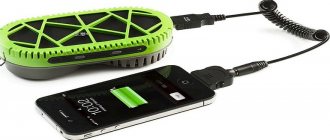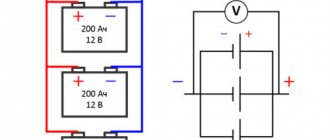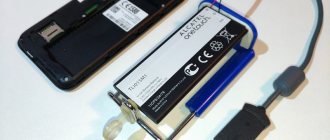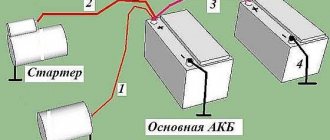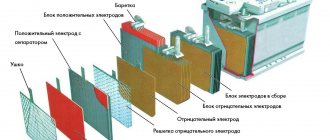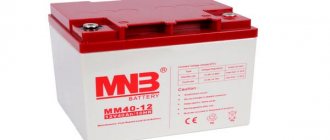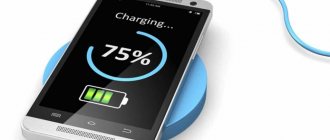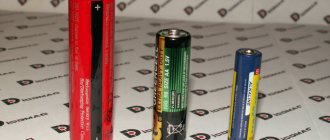Any motorist may find himself in such conditions when the car’s battery suddenly stops working, and there is no way to charge it from a conventional charger. For example, if the car has not been used for a long time and has been parked for several months, the battery will gradually discharge and stop working. In addition, if you leave the headlights on, the battery will run out very quickly overnight, and you simply won’t be able to start the car. In such cases, you should know how to charge the battery without a charger, using methods known to many drivers.
Determining the reason: diagnostics
If the car does not start, you should first find out exactly whether the reason lies in the battery. First you need to pay attention to the dashboard. If the indicators on it light up dimly or don’t light up at all, it means the battery is definitely dead. It’s good to have a voltmeter built into the dashboard: in this case, a sharp drop in voltage readings will indicate a problem with the battery.
It is also necessary to inspect the car battery itself. All modern batteries are equipped with a charging indicator, by the color of which you can tell whether the battery is low or not. When the indicator lights up red, that means it is so.
If the battery is dead, this will also affect the sound of the engine. The sound will be weak, more monotonous and very viscous, with a characteristic clicking sound under the hood. If any of these signs are suddenly detected, you will have to think about how to charge the car if there is no charge, showing a certain amount of ingenuity and sociability.
Reasons for battery drain
It must be said that sometimes there is one or another breakdown whose presence prevents the battery from being charged. The brushes may be worn out or the voltage stabilizer may not be working properly. Also a very common option is to loosely tension the alternator belt. These and other malfunctions are indicated by the battery light, which may flash periodically. In this case, you must definitely diagnose the system and get rid of the problems.
It is worth noting a situation that sometimes occurs in cold weather. For example, in the evening you leave a car that is working normally, but in the morning the starter refuses to work. In this case, most often the battery simply freezes and then it just needs to be warmed up. To do this, place it somewhere warm and wait for the electrolyte to thaw. Just don’t forcefully warm the battery, for example, pour boiling water on it or put something warm on it. Such actions can lead to negative consequences.
The “lighting” method from another car
One of the good old ways to get your car moving is to try to recharge a dead battery from the battery of another car passing by. Any seasoned motorist will tell you that if a problem arises with how to charge a battery without a charger, this is the most proven and correct way out of the situation. If a problem with the battery occurs while traveling, when it is not possible to get to the nearest technical service center on foot, other motorists will willingly and understandingly come to the rescue.
When working with batteries, keep in mind that there are many different electronic devices inside the hood of modern cars. It is important to get to the batteries without damaging them. Although, in theory, manufacturers take into account the possibility of charging one car from another, and there should be enough space for lighting. It is easy to find two terminals on the battery: positive and negative, and the positive terminal always looks larger.
In order to carry out the process of charging a dead battery from a donor car, you will need two thick wires with strong and wide clamps with a cross-sectional area of at least 10 mm2 each. The wires must be at least 1.5 meters in length and must have a dense rubber braid, otherwise they will not withstand low temperature conditions. It is not recommended to use thinner wires, because if a strong current is applied, they may simply burn out. The current strength set before applying it must be at least 200 A.
It is best to use professional wires with wide clamps and standard colors accepted in electronics: the red wire is the “positive” pole, and the black wire is the “negative” pole. Wide clamps provide the best degree of contact, and the large cross-section of professional wires transmits current most correctly.
Once a driver is found who agrees to help, you can jointly proceed to the following actions:
- First fix the “positive” clamp on the positive terminal of the battery of the car receiving assistance;
- The “positive” clamp should also be fixed to the positive terminal of the battery of the “donor” car.;
- connect the negative wires strictly in the same sequence “receiver - donor”, constantly monitoring the polarity;
- do not allow wires to touch each other;
- start the engine of the donor car for 10-15 minutes;
- Do not disconnect the wires throughout the entire process.;
- start the engine of the receiving car only after 10-15 minutes have elapsed, turning off the “donor” engine first;
- remove the clamps from the terminals without turning off the engine of the receiving car, according to the principle - “minus” from the donor, “minus” from the recipient, “plus” from the donor and “plus” from the recipient;
- let the engine of the receiving machine run for a few more minutes until the process is fully completed.
How to prepare a battery for charging
To prepare the battery for capacity restoration at home, you must follow the following instructions:
- We remove the battery from the car or disconnect it from the network; to do this, you need to disconnect 2 wires. In winter, you need to take the battery home and leave it there for a couple of hours so that the electrolyte warms up.
- Clean the terminals. We wipe the battery with a damp cloth, which must be moistened with a soda solution or 10% ammonia.
- If the battery is serviceable, then open the plugs and check the color of the electrolyte. If it is maintenance-free, then remove the plug from it to allow free release of steam.
Car pushing method
An equally old and traditional method of “boosting” the battery, allowing you to start the engine in a short time. However, at the present stage, it is important to consider that it is only suitable for cars equipped with a manual transmission.
The essence of the method: after discharge, a certain amount of energy remains in any battery, which should be enough to start the starter. You can ask people who pass by for help. When the engine starts, you should not turn it off immediately, but drive it on the road for a while in order to maximally “boost” the battery. There are more extreme methods for starting a car if the battery is dead.
How to charge the battery
How to properly charge a car battery? To charge a car battery, you need to correctly connect the charger “crocodiles” to the terminals, and then you can charge the car battery. As a rule, manufacturers mark the positive terminal in red and the negative terminal in black. But before you start charging the battery, you need to make sure that the polarity is connected correctly; to do this, you need to find “+” and “-” on the battery.
In addition, we must remember that if you start charging the battery from a charger under voltage, this can lead to the ignition of gases.
There are three modes for charging the car battery:
- auto;
- with stable current;
- with stable voltage.
These methods differ from each other in duration and productivity. If there is no automatic charge level control system, you will have to independently control the voltage or current.
In order for the battery to serve you as long as possible, you need to monitor its temperature and state of charge.
How to charge your battery in an emergency
Of course, such methods can help out when the motorist is within the city limits or on a busy highway, where the chances of meeting potential helpers are quite high. But how can you charge the battery if the driver finds himself in some remote place and the battery stops working?
In this case, there are several improvised methods for “reviving” the battery, for example:
- emergency engine start using a regular battery;
- just shake the battery a few times.
Any regular battery can be removed from a flashlight or from a phone. Then open the hood of the car and find the wire that leads from the battery to the generator, which supplies the necessary signal when the ignition key is turned. The wire should be disconnected and a battery should be inserted in its place. Give the car a good push. If possible, it is better to push it down the hill, then jump into it while moving and quickly turn the key. Remove the battery after the engine starts without turning it off. Of course, this method requires a certain speed of reaction, but when there is no other way out, absolutely anything can happen.
If the battery is lead-acid with liquid inside, you can remove it from the hood of the car and gently shake it several times so that the liquid components are evenly distributed throughout its body. Of course, it is important to observe the greatest possible safety precautions.
How often to charge your car battery
How often should you charge your car battery? Each battery has a different charging time.
The battery consists of six cans, which contain different types of electrolytes. The most popular is the lead-acid model, which is based on a liquid electrolyte.
During operation, the battery's energy capacity decreases due to:
- battery status;
- reducing electrolyte levels;
- sulfation.
Reducing the battery capacity increases the frequency of this procedure, but reduces its duration. When using the battery for a long time, it is necessary to frequently check the voltage of the device.
The normal charge level for a car battery in summer is more than 50% of the calculated value, and in winter more than 75%. This occurs due to the difference in electrolytic density and load on the battery.
Car owners recommend full recharging more than twice a year, with one of the 100% charges being completed before the start of winter.
Making a homemade charger
If the driver has enough time and appropriate conditions, you can try to make a simple device yourself.
Making a homemade charger will be successful if you have the following components:
- regular light bulb (from 60 to 200 watts);
- semiconductor diode;
- wiring with terminals with plug for socket.
The higher the power rating of the light bulb, the faster the car battery will charge. However, you should not use a light bulb with a power rating greater than 200 watts: not only the semiconductor, but also the battery may burn out. You can touch any element of the circuit being built with unprotected hands only if it is disconnected from the power source. It is important to remember that the circuit will be under very high voltage.
A semiconductor diode is necessary to convert alternating current into direct current during the charging process. When drawing up a circuit, you need to take into account that the diode will take half of the alternating current, so the power of the burning light bulb will be half as much.
The average duration of such charging is about ten hours.
If at the moment there is no time to charge the battery for several hours, but you urgently need to “revive” it, you can use a very simple scheme for making a “fast-revitalizing” charger.
Charge the battery at 220 volts
And here is another option for charging the battery from a 220 volt network, done at your own peril and risk with a high probability of killing your battery completely and being electrocuted yourself.
Another option to charge the battery without a charger is similar to the previous option. The differences are that the connection is made not through an adapter, but directly from the outlet. A 220 volt incandescent lamp is used as resistance. A diode bridge is used to rectify alternating current into direct current. A diagram of such a connection is shown below.
Charger circuit with diode bridge
This is not recommended for use by people who do not have experience working with electricity and do not know the basics of electrical engineering. Otherwise, you may end up with burnt power supplies, broken plugs, or a damaged battery. And most importantly, it is life-threatening. Therefore, if you are not sure, it is better to buy a charger and you will be able to charge the battery in a civilized manner, and most importantly, you will remain alive.
You can even indicate in the comments what kind of laptop charger you have, that is, its Volts and Amperes are usually written on the back of the unit,
and indicate how many watts you have a lamp and we will calculate for you the charging current of your battery and how long it needs to be charged with your charger. But remember that charging must produce at least 13 volts; with a lower voltage the battery simply will not be charged - no current will flow.
If you decide to purchase a store-bought charging option from our article on how to choose the right starter charger for your car
We recommend articles on this topic:
- Serial BMW X2 crossover spotted without camouflage
- RENTAL MERCEDES CAR WITHOUT DRIVER
- Sites for making money on the Internet without investments with withdrawal of money
- Rental of special equipment without intermediaries
- Renting premises in a business center without intermediaries:…
- A car as an investment: which models have the least…
- How is a vehicle registered with the traffic police?
- How to improve the taillights on a truck?
- How are tennis courts built?
- Anti-grad awning - what is it and how does it work?
- How to choose a good bed
- How to select photos for articles?
- How to choose an inexpensive but good laptop? Adviсe,…
- How to Determine Dell PowerEdge Server Generation
- How to choose living room furniture
- All about squid - what are they good for and how to cook it correctly?
- How to choose a marriage agency?
- How a topographical survey of a land plot is done.
- How to digitize an audio cassette
- Irrigation hoses: reviews from gardeners. How to choose…
- How to choose the right spare parts for special equipment?
- How to challenge the cadastral value, and not...
- How to choose an antenna for a TV: basic...
- How to choose sunglasses for a child?
- How to choose a septic tank for a private home and not make a mistake?
- Taxi as a business area: why is it so important to go to...
- How to choose a mattress
- How to choose heating radiators. Expert advice.
- Coffee beans: how to choose
- How to transport bedridden patients
